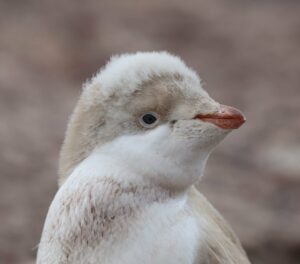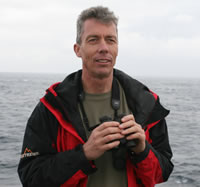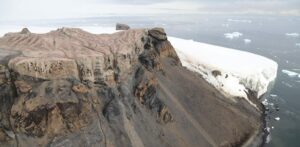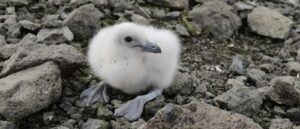By Peter Ryan, onboard scientist, expert in general ornithology, seabird-fishery interactions, evolutionary ecology, marine debris, solid waste management, biology of oceanic islands.
Leg 2, Mount Siple
We arrived off Mount Siple on the afternoon of 10 February in lovely calm weather. Ice-free areas were visible from some distance away, but we had to infer the imposing bulk of Mount Siple from its impact on the cloud illumination. Shortly after the choppers took off on a recce flight, the ship hove to next to Maher Island, a small, crescent-shaped island just offshore. The zodiaks were deployed and soon a steady shuttle of tourists was visiting the island’s sheltered bay, to be entertained by hundreds of Adélie Penguins and a couple of Emperors. There was no beach; a few intrepid souls got to leap directly onto the slippery rocks, but the routes taken by the penguins to ascend the island were impressively sheer.
Once the choppers returned, a small party visited Maher and nearby Lauff Islands, both of which had breeding Adélie Penguins and a few South Polar Skuas. Most of the penguin chicks had left the colonies, so an accurate estimate of the breeding population was not possible, but based on nest scrapes and colony extent there were of the order of 250 pairs on Lauff and perhaps 2000 pairs on Maher. There were three pairs of skuas on Lauff (at least one chick), and at least four pairs on Maher (at least two with a chick). The only other bird seen was a single Snow Petrel flying round the western cliffs on Lauff Island, but the summit of Maher bore lots of footprints of Southern Giant Petrels, doubtless attracted by the many penguin chick carcasses (and lingering chicks). We got back to the ship around 22h00, with the setting sun turning the underside of the stratus clouds golden.
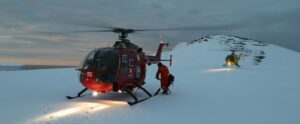
11 February was equally calm, and the choppers worked overtime to deploy the ice-coring and air bacterial samplers at around 1000 m on the slopes of Mount Siple, then shuttled parties to Lovill Bluff, a large ice-free area some 10 km west of Maher Island. The recce flight had reported a large penguin colony here, but we weren’t prepared for the many thousands of Adélie Penguins breeding over an extensive area; even with three hours ashore we had to rely on aerial coverage to get a full idea of the breeding areas. Although some chicks had fledged already (and many were wandering the adjacent beaches and ice shelf), breeding was a bit later than at Maher and Lauff, with thousands of chicks still in the colonies, accompanied by moulting adults and post-moult adults vociferously proclaiming their nest sites.
The beach below the main colony had a couple of moulting Emperor Penguins, and one had walked up to join the throngs of Adélies on the ice shelf next to the colony. The beach and adjacent ice-floes also had several Weddell Seals, three Southern Elephant Seals, and a Leopard Seal on an ice-floe that kept the penguins on their toes. Adults porpoised in at speed, literally flying ashore.
